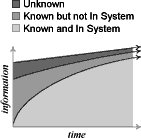| |
|
|
|
|
|
Second-Level Data Repositories |
|
|
|
|
Many current web sites contain detailed information about a particular subsection the official LEGO product line,
and some sites contain brief information about the entire product line,
but no site currently contains detailed information across the entire product line.
This is because of the enormous amount of time and resources necessary to compile such a guide.
Even if one person out there had all of the LEGO sets ever produced,
it would be a miracle if he or she could find the time to enter and organize all of the data and ensure its correctness.
What it takes to create an all-encompassing guide is a coherent group effort where anyone can contribute information on his or her own time,
and where the guide is rooted in a solid, scalable underlying design.
|
|
LUGNET makes a gigantic, orchestrated group effort possible
|
|
|
The LUGNET Guide to LEGO Products will take several years to complete, even with the combined resources of hundreds of contributors.
In fact, it may never even be completely complete since obscure old sets continue to turn up around the world from time to time.
Nevertheless, the Guide will achieve almost immediate usefulness,
since it is likely that the majority of specific requests for information fall into the most popular 10% or 20% of the product line,
and it is likely that the Guide will be 80% complete a year after Phase II is launched and 95% complete after two years.
It is expected that the largest data growth period will occur in the first two to three months of Phase II as existing data repositories on the Web are voluntarily contributed and converted.
|
|
The product guide will grow along a curve

|
|
|
The Guide is organized hierarchically to match the official LEGO product line.
At the bottom is a repository categorizing All Pieces, complete with names, sizes, keywords, and renderings, drawings, or photos for each piece (element).
Above this is a repository of Piece Inventories, which itemizes the contents of each Set (kit) and of each member-designed model.
This serves the repository of All Sets and of a Member Idea Book.
In the diagram earlier shown, the Member Idea Book is positioned slightly closer to the Piece Inventories than is the repository of All Sets, even though the two are essentially both lists of pieces.
This anomaly exists because a primary function of the Member Idea Book is to serve as an encyclopedia of componentized ideas which will be tied in closely to the parts markets in Phase III.
That is, someone is more likely to attempt to acquire all the pieces in a given Idea Book object separately than they are to acquire all the pieces in a given Set separately,
since Sets are chiefly available whole and there is no entity producing whole, encapsulated Member Idea Book objects (although it is interesting to ponder the possibilities of this).
|
|
At the bottom of the Guide hierarchy are pieces and building sets
|
|
|
Sets are futher organized into categories called (by the Lego Group) Themes, which lie within Systems, which lie within product Programmes.
Examples of Themes are Blacktron, Paradisa, Divers, and Islanders.
Examples of Systems are the Space System, the Town System, and the Technic System.
Examples of product Programmes are LEGO Primo, LEGO DUPLO, Belville, Scala, and The LEGO System (formerly known in the 1980's as Legoland).
Placement of themes into systems and systems into programmes will be an difficult task, since many of the exact placements are debatable.
The All Themes repository, the All Systems repository, and the All Programmes repository will hold these placements.
An additional repository of All Value Packs will also contain information on meta-sets --
that is, sets which contain other sets, such as the 5-Item Bonus Pack from 1993 which spanned four different Systems.
|
|
Each building set has a place in a large hierarchy
|
|
|
Omniscient to all of this is the repository of All Catalogs, which may someday contain comprehensive high-quality scans of all pages.
Initially, however, it will simply support a photo of the cover of the catalog and a list of all sets, themes, systems, and programmes covered by the catalog.
Lists of sets will help people make informed purchasing decisions as they consider various old collectable catalogs up for sale in the marketplace.
Coverage will include standard multi-page catalogs, single-sheet catalogs, gatefold catalogs, Shop-At-Home catalogs, and possibly also general Service Catalogs.
Datafication must also handle multiple issuances of a given catalog ID (catalog IDs look like 925.375-NZ and 4.112.635/4.112.636-NA), because catalog IDs are not always unique
(in 1996, each sheet catalog in the U.S. had two versions each with the same ID -- one each pre-Wild West and one each post-Wild West).
|
|
Catalogs provide an additional index
|
|
|
A repository of private Annotations will sit beside all of the product information so that people can make notes to themselves about pieces, sets, or whatever they like.
These annotations will show up whenever people re-visit pages which they have marked up.
The Annotations repository will double as a Voting tracker, so that any votes cast on pieces or sets (or whatever object) are simply a special case of an annotation.
(Hence the close logical association with the Voting repository.)
The Annotations repository also serves the marketplace, which is a nice segue into Phase III -- "buying, selling, and trading everything under the sun."
|
|
Objects in the system can be loaded with annotations
|
|
|
Next page |
|
|
|
